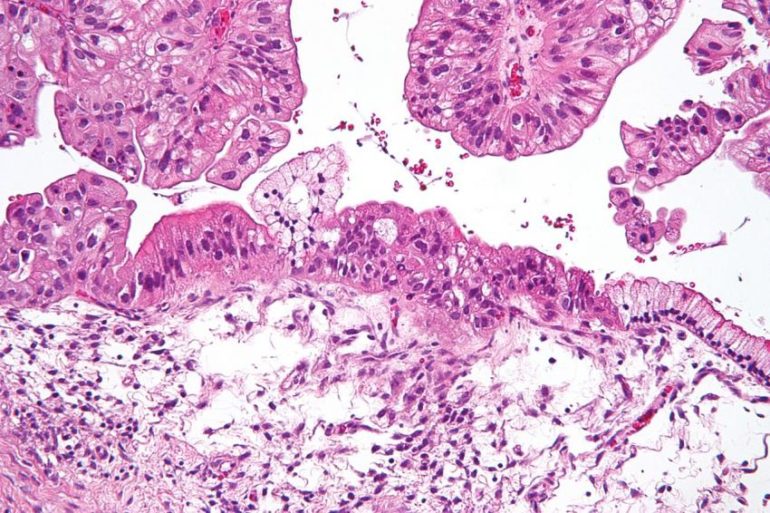A gene called DOT1L appears to play a role in progression and severity of ovarian cancer, and inhibitors of the DOT1L enzyme may offer a new therapeutic approach for the disease, University of Alabama at Birmingham researchers say in a study published in the journal Oncogenesis.
The need is clear—despite decades of work to develop new treatment modalities, the five-year survival of patients with advanced ovarian cancer is between 10 and 30 percent.
Others have found that DOT1L is overexpressed in several cancer types, and recent clinical work has shown synergistic antiproliferative activity for a DOT1L inhibitor against MLL-rearranged leukemia.
The UAB researchers, led by Romi Gupta, Ph.D., assistant professor of biochemistry and molecular genetics, now show that DOT1L promotes ovarian cancer tumor growth by stimulating pro-tumorigenic metabolic pathways and blocking the programmed cell death called apoptosis.
Gupta and colleagues first looked at data sets from patients. They found that DOT1L expression was significantly higher in tissues from ovarian cancer patients compared with tissues from healthy patients. Furthermore, patients with ovarian tumors that had high DOT1L expression showed shorter progression-free survival and shorter overall survival rates compared with patients whose ovarian tumors had lower DOT1L expression.
DOT1L is a histone methyltransferase that epigenetically methylates the histone H3 lysine 79 in chromatin, and this alters gene expression in cells. The UAB researchers found that EPZ-5676—a DOT1L inhibitor that has been used in several clinical trials to treat MLL-rearranged leukemia—was able to block the growth of ovarian cancer cells in culture. EPZ-5676 also significantly blocked subcutaneous ovarian cancer tumor growth in a mouse xenograft model.
Mechanistically, DOT1L inhibition downregulated the expression of various genes that are required for biosynthetic pathways and reduced the levels of essential biosynthetic metabolites in the ovarian cancer cells. DOT1L inhibition also upregulated genes involved in programmed cell death, which increased apoptotic cell death for ovarian cancer cells in culture. The pharmacologic inhibition of DOT1L also upregulated expression of ligands for natural killer cells in some of the ovarian cancer cell lines tested.
These gene expression changes seen in DOT1L inhibitor-treated cells thus suggest that DOT1L overexpression in ovarian cancer leads to plentiful supplies of the metabolites needed for rapid tumor growth and also protects against tumor cell death caused by apoptosis or natural killer cell attack.
“Our results suggest that DOT1L might be a pharmacologically tractable drug target for ovarian cancer therapy,” Gupta said. “It will also be useful in combination with other immunotherapeutic agents to further enhance their effectiveness in treating ovarian cancer.”
Co-authors with Gupta for the study, “Disruptor of telomeric silencing 1-like promotes ovarian cancer tumor growth by stimulating pro-tumorigenic metabolic pathways and blocking apoptosis,” are Suresh Chava, Suresh Bugide and Yvonne J.K. Edwards, UAB Department of Biochemistry and Molecular Genetics.
Support came from National Institutes of Health grants CA230815-02 and CA248913-01.
Study may widen patient pool that benefits from EPZ-5676 against acute myeloid leukemia
More information:
Suresh Chava et al, Disruptor of telomeric silencing 1-like promotes ovarian cancer tumor growth by stimulating pro-tumorigenic metabolic pathways and blocking apoptosis, Oncogenesis (2021). DOI: 10.1038/s41389-021-00339-6
Provided by
University of Alabama at Birmingham
Citation:
Ovarian cancer: Potential therapeutic target identified (2021, August 5)
retrieved 5 August 2021
from https://medicalxpress.com/news/2021-08-ovarian-cancer-potential-therapeutic.html
This document is subject to copyright. Apart from any fair dealing for the purpose of private study or research, no
part may be reproduced without the written permission. The content is provided for information purposes only.



